
I would like to begin foremost with a promise to the reader:
Nowhere in this article will you find a single criticism of Paganism or Pagan beliefs, for it is neither the aim nor the purpose of what is being conveyed. Neither will you find a single criticism of Christianity. If the reader considers themselves to be either Pagan or Catholic, then there is written nothing in this article that should cause them any offense, or otherwise be considered as disrespectful. And to the Catholic reader, I promise you I am not a Jesuit. To put it plainly, this article does offer strong criticisms against modernism, but nowhere does it criticize anything from antiquity.
Paganism & Neo-Paganism
Nothing that is profound will ever be easily obtained. A simple understanding of anything, let alone religion, will always turn up wrong in the end. It is important to bear in mind that if anything from antiquity becomes popular again in broader culture, it is likely interwoven with many falsehoods in order to make it seem adjacent with modern customs and tastes. One example of this is the classicization of Thor, the red-bearded Germanic deity, in the painting ‘Thor's Fight with the Giants’ by Swedish painter Mårten Eskil Winge, which was painted in the late 19th century, a time when Roman & Greek traditions were far more in vogue than Germanic traditions.
Does there even exist a relevant difference between Paganism and neo-paganism, or are these terms simply interchangeable? Is ‘neo-pagan’ nothing more than a derogatory slur, or might we take its meaning literally: ‘New Pagan?’ In any case, is it even possible to distinguish between the two, and if so, why does it even matter?

We need not state the obvious distinction, that neo-paganism most typically refers to Paganism practiced in modern times. Aside from this mundane definition, arguably one of the most distinguishing characteristics of neo-paganism has become one of its foremost features, to the point of becoming a defining principle of the movement itself: the explicit rejection of, and overt antagonism towards, Christianity.
The neo-pagan, (often hailing from a protestant-majority nation, or otherwise the descendent of anti-Catholic protestants), is fervently anti-Christian. This can essentially be considered an exaggeration conceived out of the fact that historic Pagans were anti-monotheistic, which is true. Pagans were effectively always resistant to abandoning polytheism.
(The Pagan philosopher Socrates did propose a version of henothism—the belief that there exists one primary deity that reigns supreme above all other deities—but by no means was this a commonly held belief among European Pagans, and Socrates was eventually accused of impiety and later sentenced to death.)
However, inasmuch as resistance to monotheism is indeed historically true, we can likewise observe that historic Pagans were not principally anti-Christ. The invocation of the Christ God, when offered by missionary Priests without stipulation, was often welcomed by the Pagans of yore.
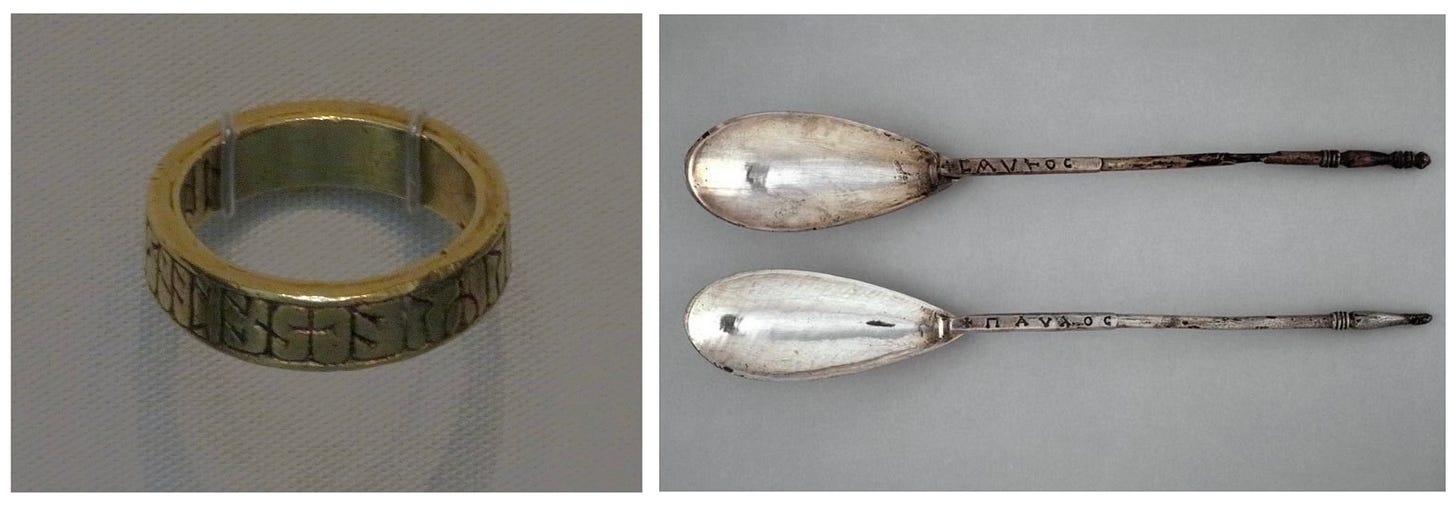
One example of such polytheism can be observed in this excerpt taken from Landnámabók, which describes the syncretic beliefs of a man named Helgi the Lean during the Norse settlement of Iceland in the 10th Century:
« Helgi was mixed in his Faith; he believed in Christ, yet invoked Thor when it came to sea-faring and hardy things. When Helgi sighted Iceland, he consulted Thor as to where he should put in. The answer directed him northward round Iceland. Then his son Hrolf asked Helgi whether he was planning on sailing to the Arctic Ocean if Thor told him to go there? »
[Helgi named the point that Thor led him to ‘Kristnes’, or Christ’s Headland.]
— Landnámabók, S. 217-218
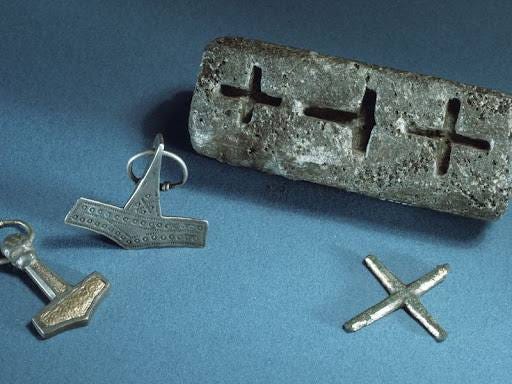
Another example of such polytheism towards Christ can be found in this excerpt taken from Njáls Saga, which offers us a glimpse of the plausible interactions that may have occurred between Catholic Priests and devout Pagans:
« Then it was said that there were two-hundred heathen men to meet them, and that a Berserkir was looked for to come thither, whose name was Otrygg, and all were afraid of him. Of him such great things as these were said, that he feared neither fire nor sword ...
[A Catholic Priest, Þangbrandr, spake]:
“We shall bless two fires. The heathen men shall bless one, and I the other, but a third shall remain unhallowed; and if the Berserkir is afraid of the fire that I bless [in Christ], yet treads both the others, then ye shall take fully my faith.”
[The Norse Pagan Gest replied]:
“That is well-spoken, and I will agree to this for myself and my household.” And when Gest had so spoken, then many more agreed to it. »
— Njáls Saga, Ch. 99 - 'Of Gest Oddleif's Son'
The conflict concludes with the berserker Otrygg arriving, not crossing the hallowed flames, and the Catholic Priest thrusting his sword through his chest, as the Pagan men likewise descend upon the berserker with their own weapons. (For those who may view this tale merely as Christian, or otherwise doubt such perspectives among historic Pagans, I recommend this video from Dr. Jackson Crawford, Professor of Old Norse Studies.)
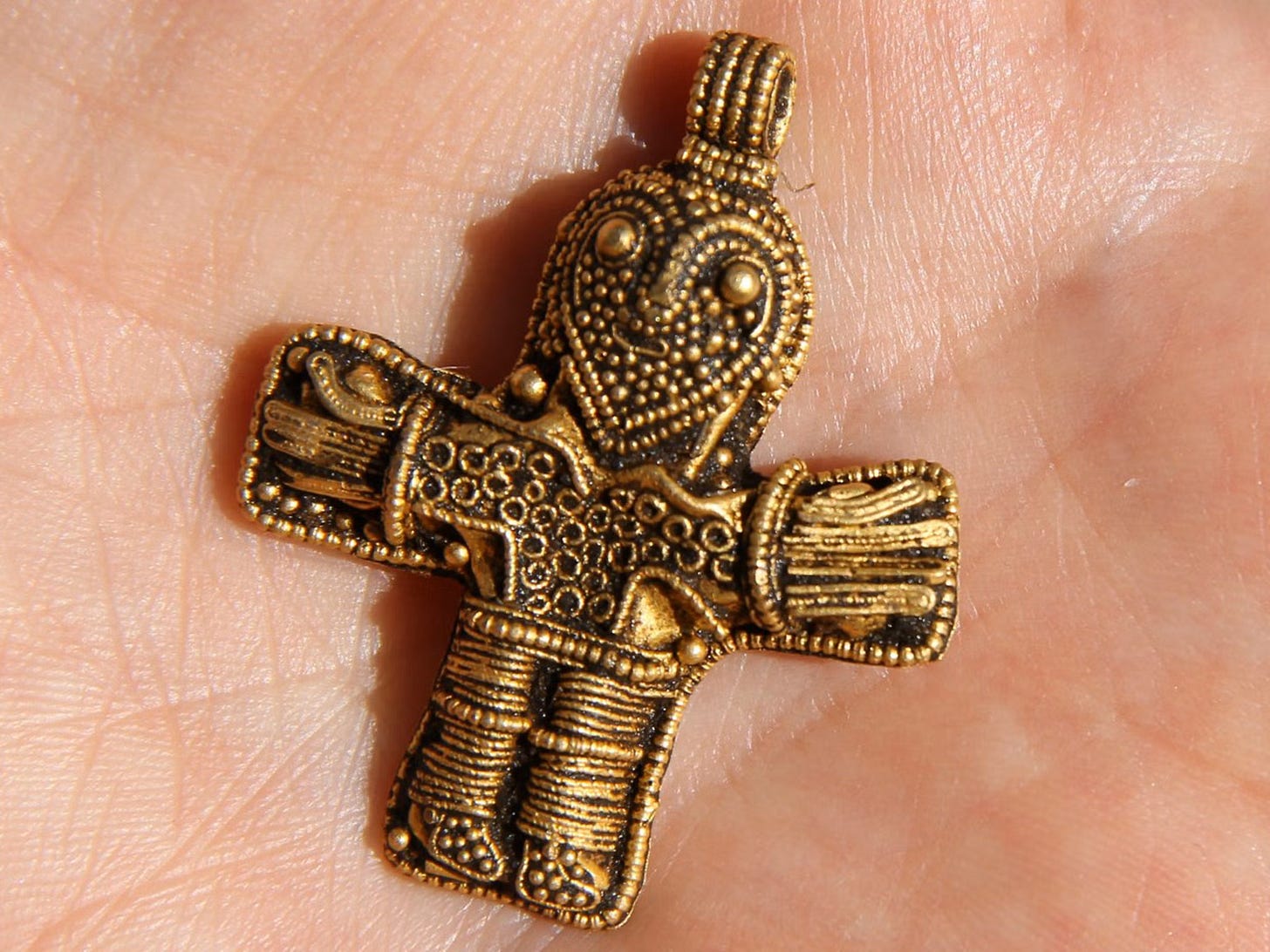
Three important elements stand out in this Saga excerpt:
I .) The Catholic Priest, Þangbrandr, invited the Pagans to bless their flames in accordance with their own magical customs, proposing a form of mystical challenge rather than rebuking them for their heathenry.
II .) The Pagan leader, Gest, did not oppose the mystical aid of a foreign God, so long as it was effective in solving the tribulations he and his men faced.
III .) The Pagans in this excerpt do not rebuke the Catholic Priest for offering Christ’s blessing, rather they seem loyal to their leader’s opinion and ambivalent over whether or not the foreign God’s invocation will actually be effective.
One could hardly imagine it being welcome, or even permitted, to invoke the name of Jesus Christ in a friendly blessing at the ‘Midgardsblot Metal Festival’ held annually in Borre, Norway—a popular attraction for many self-proclaimed Pagans.

The dichotomy that is presenting itself is that the neo-pagan of today treats their pantheon as exclusive, something that would have been unfamiliar to our polytheist ancestors who did not outright reject foreign deities as non-existent, or merely for being foreign. Rather, just as we might expect from polytheists, historic Pagans expressed ambivalence, not rejection, towards the power of foreign deities.
In just the same way, if we look to the East in modern times at cultures that have retained an unbroken tradition of Paganism, we can witness firsthand how they react to Jesus Christ when presented with Christian sacramentals, icons and statues.

Runestones are ubiquitously understood as being deeply associated with Germanic Paganism, and the nation with the highest abundance of Runestones in the world is Sweden. In Hávamál, Odin sacrifices himself, to himself, in order to learn the wisdom held within the Runes of his day.
« I know that I hung, on a wind-rocked tree, nine whole nights, with a spear wounded, and to Odin offered, myself to myself; on that tree, of which no one knows from what root it springs. Bread no one gave me, nor a horn of drink, downward I peered, to runes applied myself, wailing learnt them, then fell down thence. »— Hávamál, Stanzas 140 - 141
Of the roughly 2,500 Runestones recorded in Sweden, approximately 1,300 of them contain Christian elements—or roughly 52% of all Runestones in Sweden. Does this mean that the majority of Runestones in Sweden were erected by Christians? No, not necessarily. Many of those same Runestones were likely erected by Norse Pagans, whose polytheism did not inhibit them from invoking Christ for their own purpose.
Where modern man reacts to foreign religions with agnosticism, ancient man reacted with syncretism—for those ancient people were fundamentally religious in ways that we in the West rarely are today. It cannot be emphasized enough that there is nothing less Pagan than atheism, which is most certainly a modern affliction we inherit from the Enlightenment.
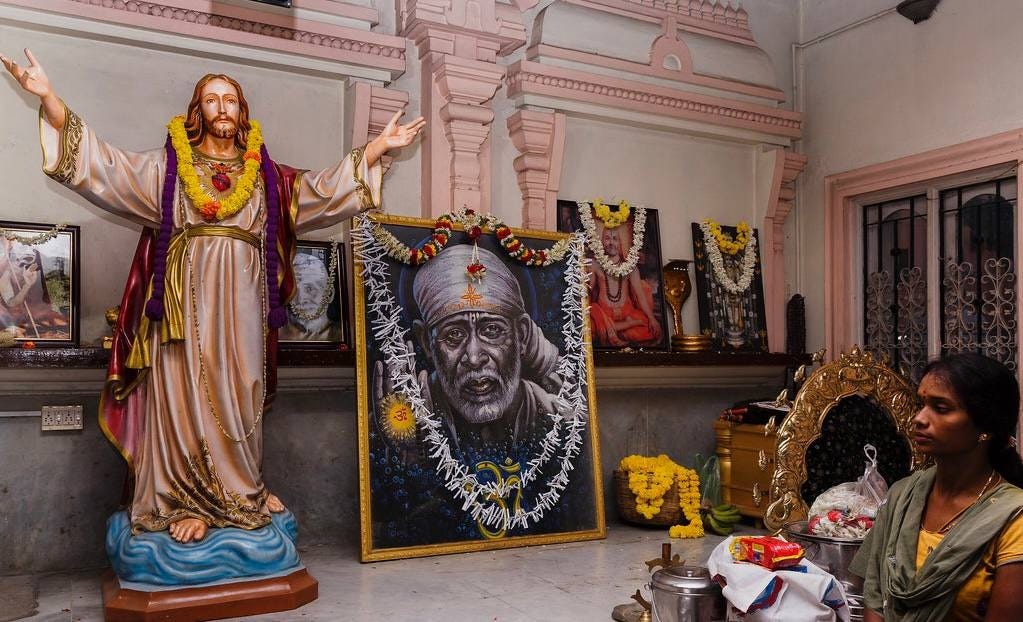
Protestantism & Modernism: The Enemies of Sacrifice
“ The hussites are wearing Mjölnir . . . ”
If the polytheistic Pagans of ancient Europe were not so principally anti-Christian as is often believed, from where then do the neo-pagans we speak of inherit their anti-Christian principles? Surely we can conclude that, at the very least, our ancient Pagan ancestors are proud of these neo-pagans for protesting the Christians, right?

Taking into consideration all that we have outlined thus far, we must take into account the world in which modern man is born. We live in a time fundamentally different than what our Pagan ancestors had to contend with. Where our ancient ancestors were focused on yielding a fruitful cycle of crop rotations and defending their families against dishonor, it is not uncommon today for us to be fired from our jobs for saying something politically insensitive on the internet, be it about the ‘LGBT+’ movement or free speech. But how did we find ourselves living in a society that defends such things as gay marriage and free expression? To say nothing of those wicked actors who profit from our societal downfall, fundamentally, these things trace their philosophical origins to the ‘Enlightenment’ of the late 1600’s.

The ‘Enlightenment’ evolved out of principles established by protestant thinkers during the ‘Protestant Reformation,’ which began in 1517AD—a period wherein many European Christians were led astray from the ancient Catholic traditions they inherited from their ancestors by rogue theologians who promoted the concept of ‘sola scriptura’ (scripture alone)—the revolutionary concept that the only thing a person needed in order to faithfully abide by the Christian religion was their own individual interpretation of the Biblical texts.
Naturally, ‘Enlightenment’ thinkers took this concept further by promoting societal ideals such as ‘individual liberty,’ ‘skepticism of authority,’ ‘progressivism,’ ‘scientific empiricism,’ ‘democracy,’ ‘secularism,’ ‘natural rights,’ and ‘equality.’ From all of this developed the philosophy of modernism as such, which arguably reached its tendrils as distantly as the eventual development of marxism in Germany and England.
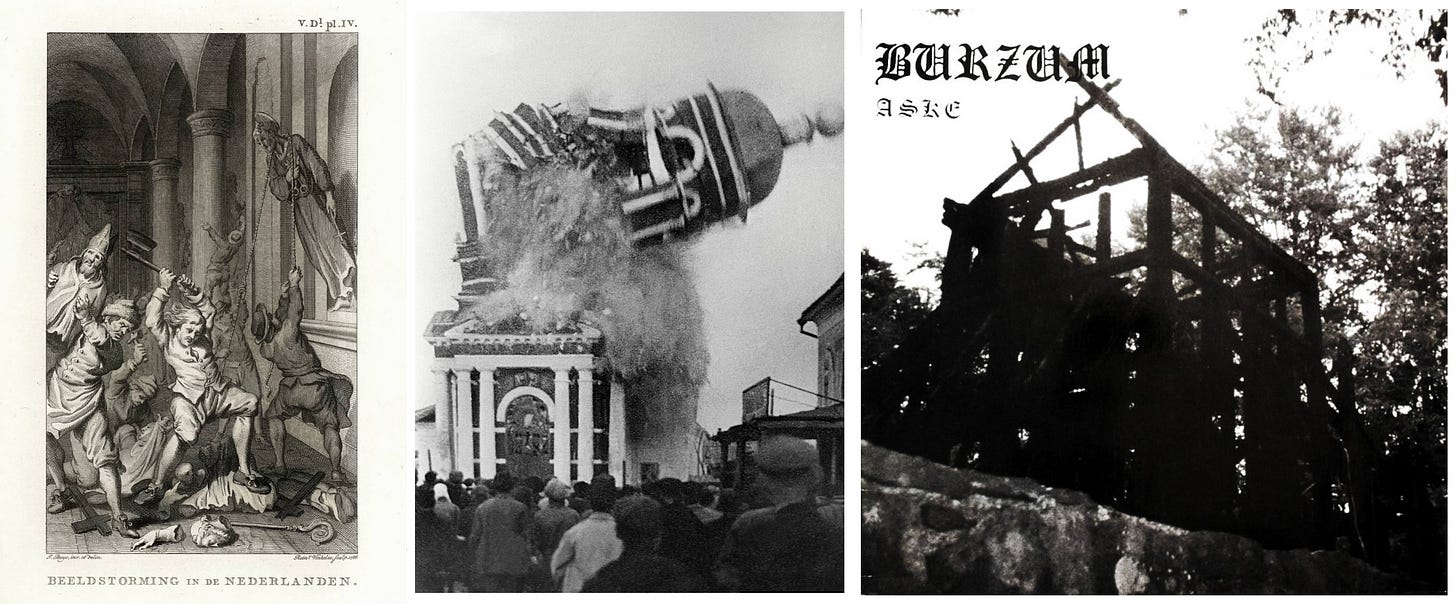
The Catholic Church did what it could to combat the protestant heresies as they spread, leading to countless battles and wars. It is worth mentioning that the notion that protestants were merely ‘fighting against corruption’ within the Church is greatly overstated—for the Catholic hierarchy itself dedicated an impressive amount of effort towards rooting out corruption within its own Dioceses across the continent, which catalyzed as the Counter Reformation. But without delving too deeply into Early Modern history, by the year 1900AD, the following European nations were majority protestant:
Norway, Sweden, Denmark, Iceland, Finland, England, Scotland, Wales, Germany (Prussia), Netherlands, Switzerland, Estonia, Latvia, and if we include the wider Anglosphere: The United States, Canada, Australia, New Zealand, South Africa, and the British Caribbean territories.

Today, in the year 2025AD, a significant number of these nations have drifted completely into atheism and liberalism. Is it any wonder that the spiritually starved peoples of these lands yearn for an ancient faith? Personally, I do not cast any stones your way, dear friends. For how can any Catholic blame another for rejecting protestantism? You ought to reject it.
Ask any self-ascribed Pagan residing in any one of these countries what the Christians believe happened to their Pagan ancestors who died before the coming of Christ, and they will most likely respond: “the Christians believe that their heroic Pagan ancestors were banished to Hell.”
However, this is a protestant heresy, and never has it been the Christian interpretation, which upholds the teaching of Invincible Ignorance.
“Q. 632: What is invincible ignorance?
A: Invincible ignorance is the ignorance of those who have never had the means of knowing the Christian faith.
Q. 633: Will invincible ignorance excuse a person from sin in the sight of God?
A: Invincible ignorance will excuse a person from sin in the sight of God if he has lived up to the dictates of his conscience; for in such a case his ignorance is not his fault.”
— The Baltimore Catechism No. 3, Q. 632 - 633
In particular, the popular but erroneous notion that Catholicism was never deeply intertwined in the hearts and minds of the Scandinavian people, for example, is likewise untrue. The very first European King to ever step foot within Constantinople was a Norseman, King Sigurd I of Norway, during the Norwegian Crusade.
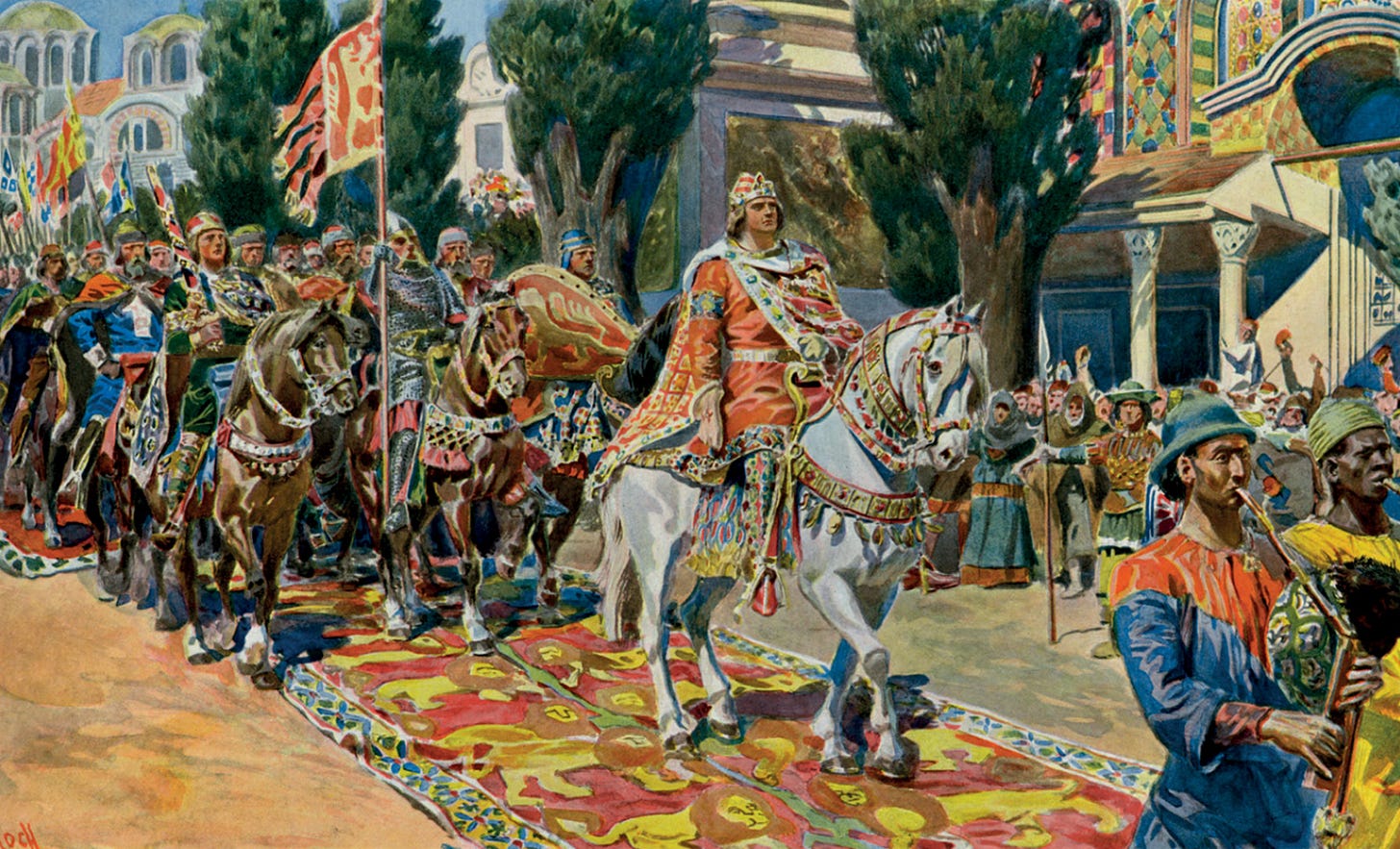
When inspecting these observations altogether, it can be reasonably inferred that the neo-pagan of the 21st century most likely inherits their anti-Christian fervor not from their Iron Age Pagan ancestors, who often were ambivalent towards Christ, but unwittingly from the Enlightenment ideals they culturally adopt from their anti-Catholic protestant forebears of much more recent history, who no doubt would be just as proud of them for opposing those “heathen Catholics” partaking in ritual sacrifice at Mass as much as they would be disappointed in them for no longer believing in Jesus.
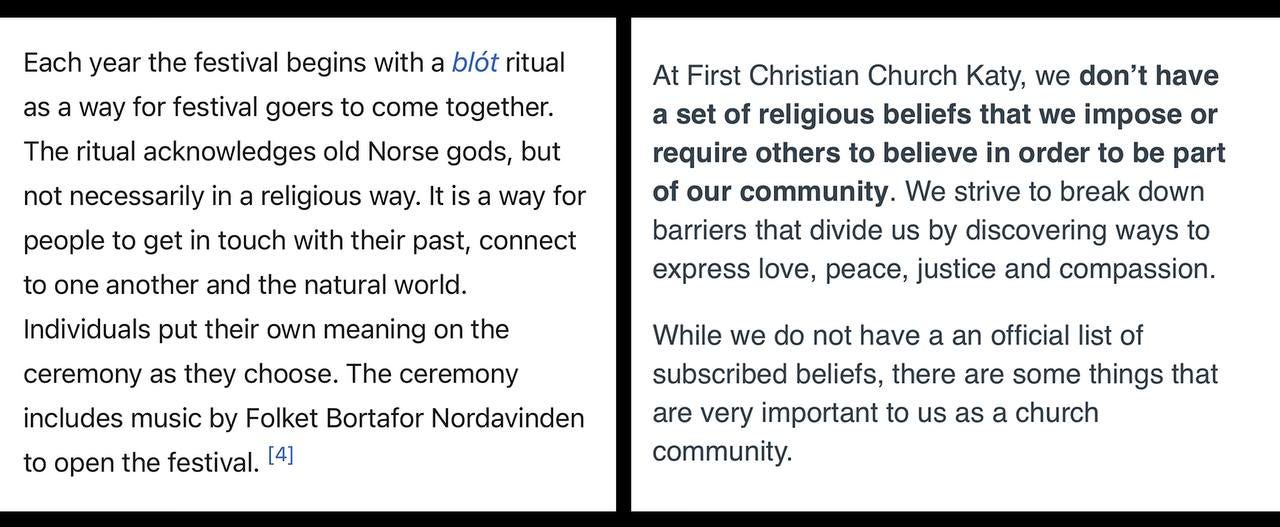
Guido List was a prominent 20th century neo-pagan and the progenitor of a self-described new pagan occult movement he called ‘armanism.’ Guido decided to marry another woman following a divorce with his previous wife in August of 1899—the subsequent wedding was held in an evangelical protestant church. This was in spite of the fact that he was Austrian; Austria being predominantly Catholic during this period.
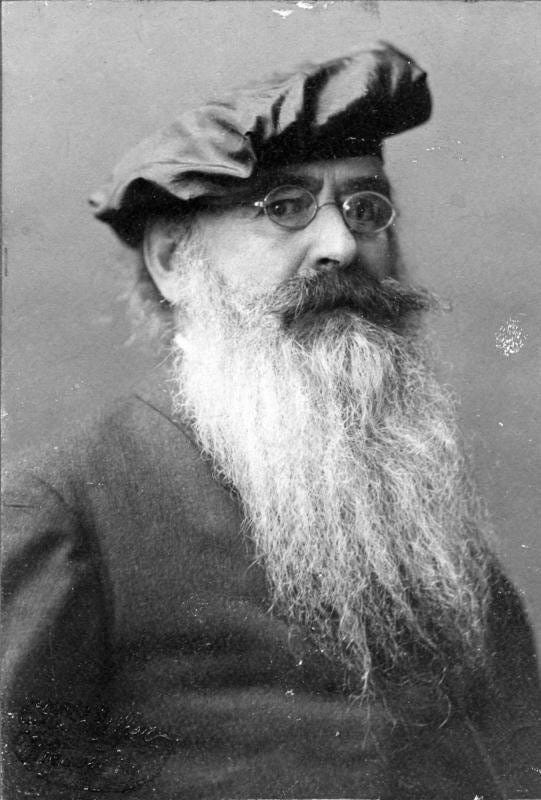
Protestantism was becoming increasingly popular within the pan-Germanic political movement of the early 1900’s—many of its constituents turned their backs on Monarchism and their Catholic roots, such as Guido himself. It is important to identify that the vast majority of ethno-nationalist neo-pagans can trace their interpretations and beliefs back to Guido’s work (circa 1890AD), not Medieval history. Such individuals can therefore be most accurately described as practitioners of armanism, not Paganism.
Taking these observations into account, it is far more likely that Guido List and his followers were unwittingly passing on the torch of protest against Catholicism from prior centuries as an accessory that complemented their political movement rather than restoring ancient religious practices. Guido invented an alphabet of fictional pseudo-runes he called ‘armanen futharkh,’ and attempted to submit a manuscript to the Imperial Academy of Sciences in Vienna, but the university rejected the manuscript and refused to have it published. Before continuing, the reader is encouraged to note that there is no evidence suggesting Guido List ever practiced animal sacrifice despite his occult hobby.
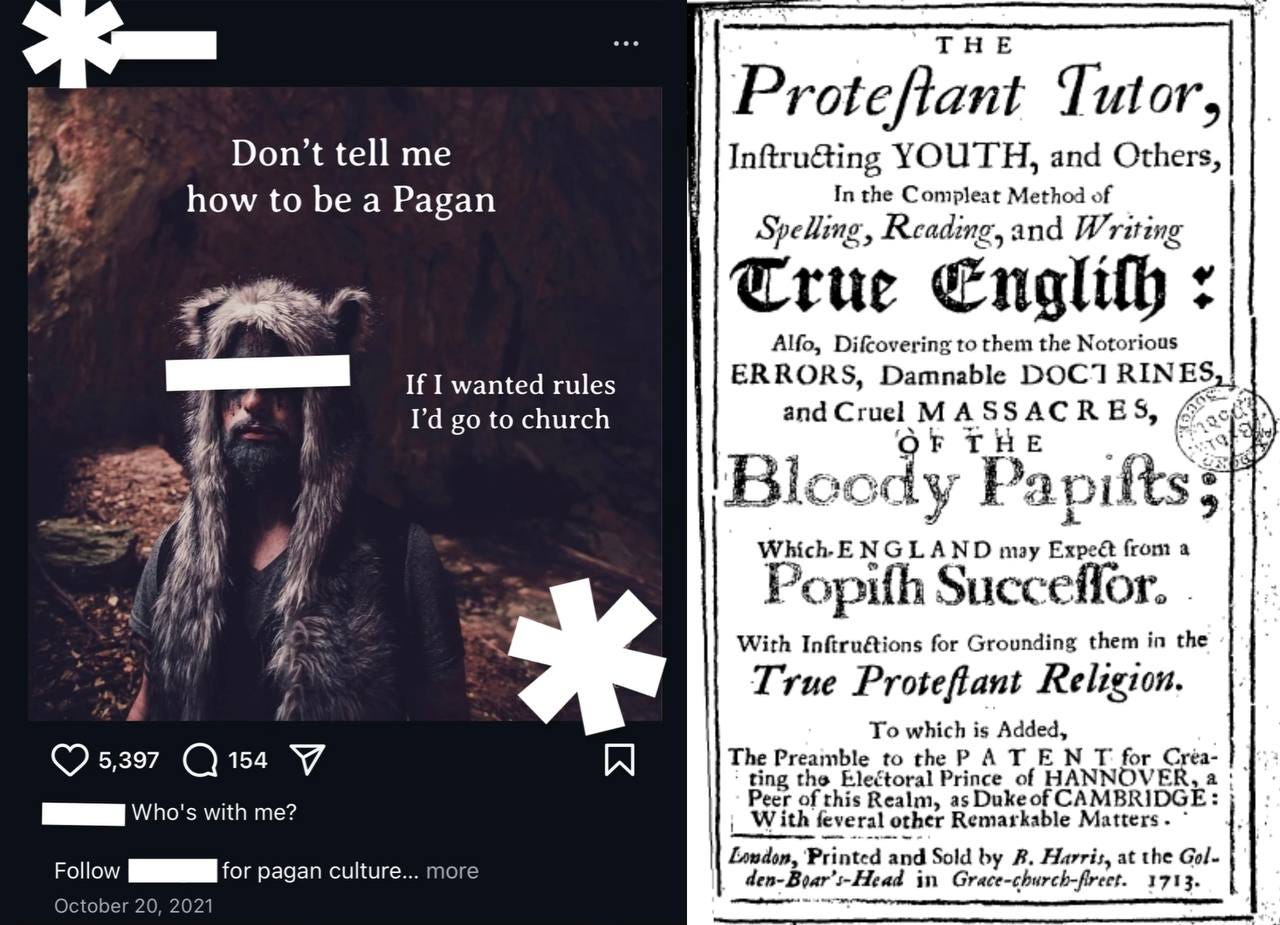
“But how can you argue that being anti-Christian developed from protestantism when protestants themselves are Christian?”
Rebelliousness is a cancer that only ever intensifies with time. When a 16th century Christian decides to protest the original Church, his descendants will eventually protest the Sacraments themselves, and that person's descendants the belief in Christ entirely. To neglect the Sacraments within the Christian religion is to take the wind out of its sails—the vehicle of Faith that carries that lineage will always inevitably come to a complete stop in due course, as we can now tragically observe in post-protestant agnostic Scandinavia.
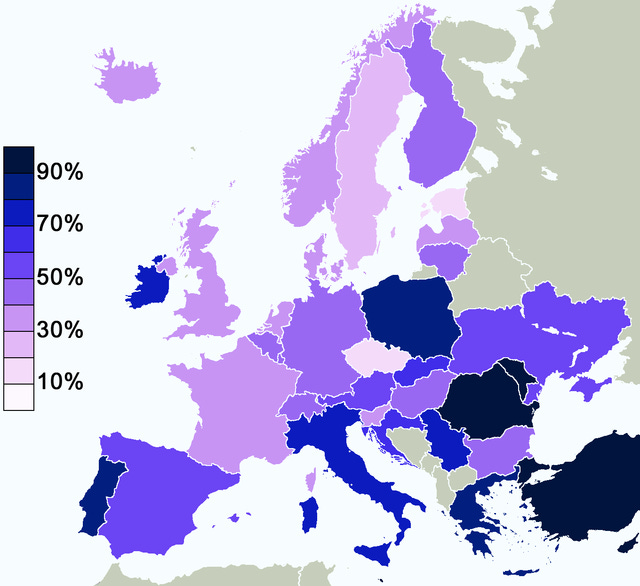
“But some protestant Christians still believe in the sacraments.”
To say nothing of the invalidity of such sacraments, as I outline above, the rejection of other core tenets established within the original Church will eventually lead to a gradual distancing of those protestants from other core beliefs. This is why, at the beginning of the protestant rebellion in the 1500’s, there existed primarily only Lutheranism, Calvinism, Anglicanism and Anabaptism — however today, there are an estimated 45,000+ protestant denominations, the largest of them being atheism itself, in my view.
It is important to note here that the atheist movement in the West (which peaked in the early 2000’s) likewise traces its fervent anti-Christian sentiments to the anti-Catholic ‘Enlightenment,’ for atheists in the West invariably protest Christianity far more intensely than any other religion for this reason, despite having shed their once-protestant identity for total atheism. Pointing out that a significant number of neo-pagans converted from atheism would be beating a dead horse.
Herein lies the greatest irony:
It is hypothetical, I argue, that the protestant ancestor of the modern neo-pagan is at least grateful that their descendent does not indulge in blood sacrifice like those heathen Catholics do when they consume the Eucharist at Mass.
Alternatively, the Pagan ancestor of the modern Catholic is at least grateful that their descendent still participates in a weekly blood sacrifice to receive the favor of a prominent God. It is unlikely that they would be empirically skeptical of the veracity of transubstantiation, (the consecration of bread and wine into flesh and blood by a Priest)—for they themselves would not be unfamiliar with such mystical concepts, nor would they be subject to the same scientific empiricism that we are biased with today as modern people, post-Enlightenment.
Whatever the hypothetical case may be, it must be emphasized that it was blood sacrifice, not mere celebration, that truly rests at the heart of those ancient Pagan religions. In a similar sense, the Eucharist in Christianity, believed to be the flesh and blood of Christ that Christians consume at Mass, is considered “the Source and Summit of the Christian Faith.”
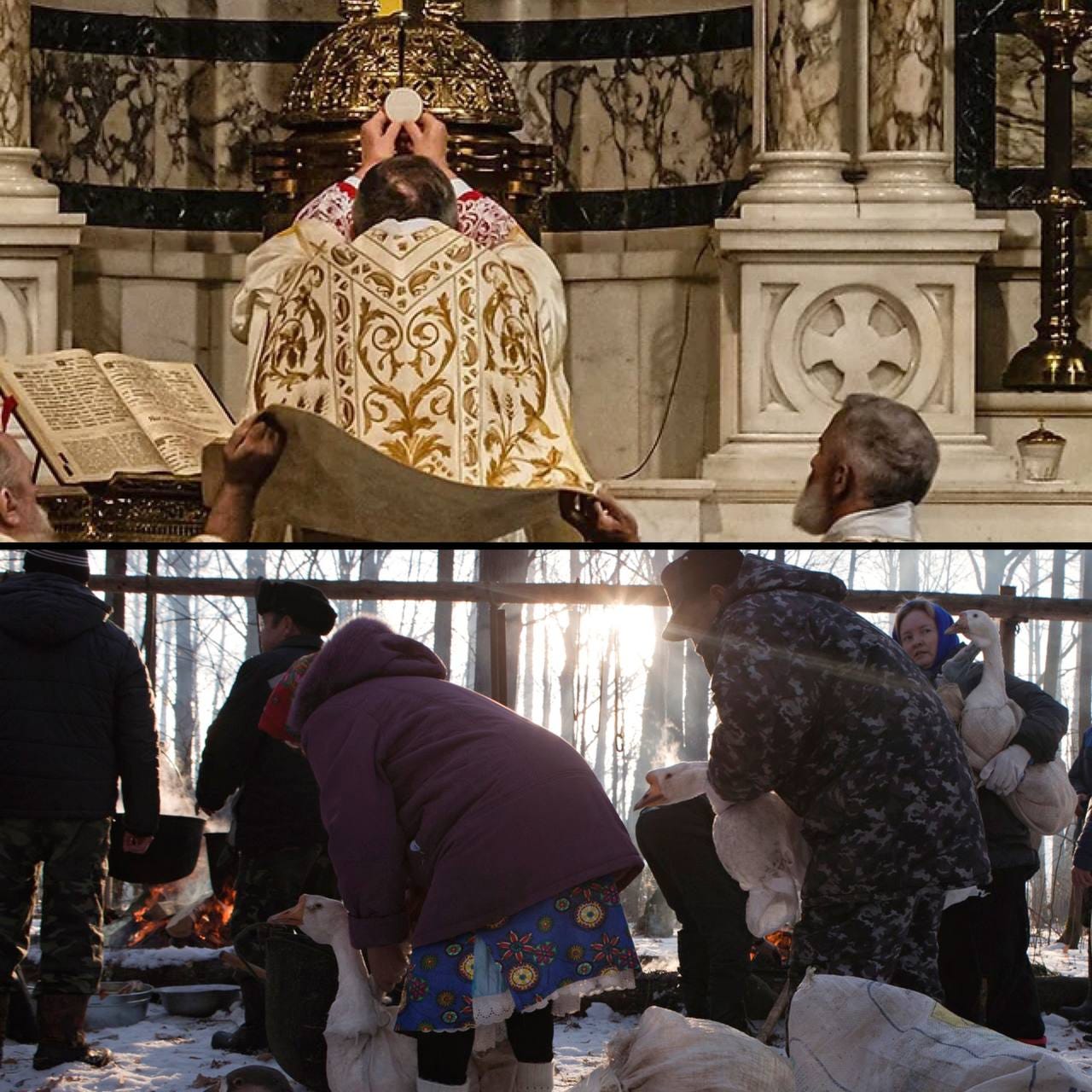
Pictured above in the second image is a gathering of Mari people from the Mari El Republic, lining up to offer geese in a ritual blood sacrifice according to their old Pagan faith. In the native religion of the Mari people, the goose is considered sacred, symbolizing various elements such as water, earth and sky. In gatherings such as the one depicted, each family rushes forth with their own goose to offer as a sacrifice.
Before offering the life and spirit of the animal, the Mari consider it crucial that each goose is calm and soothed, otherwise the good wishes behind the offering will be snuffed out and unfulfilled. In order to manage this successfully, the Mari caress each goose with a birch leaf that has been moistened with water and heated over a flame to act as a comforting blanket for the bird.
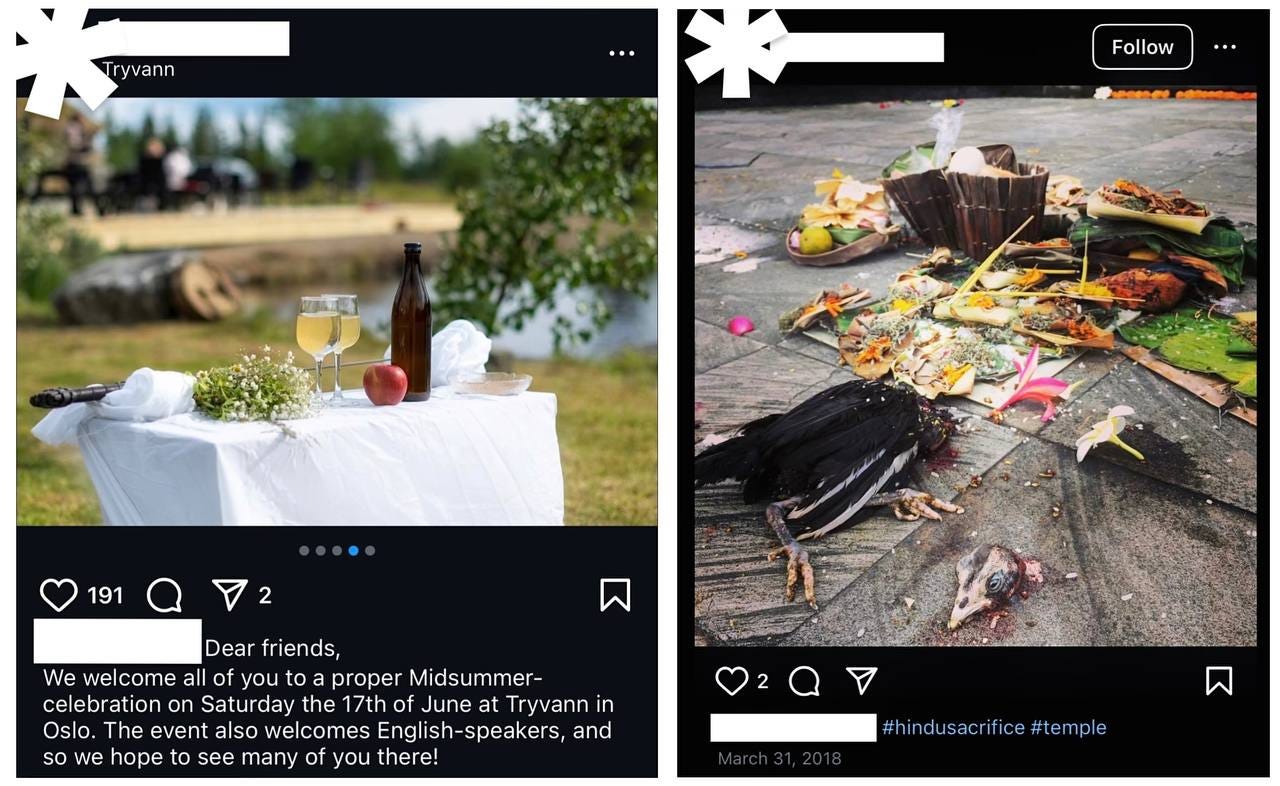
I thought to carry out a simple experiment on Instagram, wherein I searched under both hashtags #Pagansacrifice and #Hindusacrifice, respectively. In the image on the left, we can observe what is being offered by self-ascribed Pagans for the Midsummer ceremony—in this case, an apple, two glasses of mead and possibly a sword. Alternatively, depicted in the image on the right is the humble individual sacrifice offered by a single Hindu, featuring a living bird they have beheaded alongside various articles of food.
The difference between the two offerings does not go unnoticed, most especially when we consider the importance of the Midsummer holiday (holy-day) celebration among Pagans; the celebration of the summer solstice. If we are to take the devotion of these Pagans at face value, I feel it would be remiss not to ask the obvious question: where are the animals?
One stanza from Hávamál is occasionally invoked by neo-pagans to excuse their abandonment of blood sacrifice and routine prayer, wherein Odin rebukes greediness in both:
« It is better not to pray at all than to pray for too much; nothing will be given that you won’t repay. It is better to sacrifice nothing than to offer too much. Odin carved this before the birth of humankind, when he rose up and returned again. »— Hávamál, Stanza 147
In this stanza, Odin warns his subjects that he shall not be reduced to becoming a ‘wish-granter,’ proclaiming that it is ‘better not to ask for anything than to ask for too much’ from a deity. Note that Odin is praising the virtue of Temperance, one of the 7 Christian Virtues and the antithesis of greed—this in spite of how historic Pagans are frequently depicted as having been gluttonous buffoons.
With regard to sacrifice, in this stanza Odin wisely advises his subjects to prioritize the quality, not merely the quantity, of the prayers and sacrifices they offer.
However, to interpret Odin in this stanza as pontificating that it is better his subjects ‘not pray […] too much’ and ‘not offer sacrifices of high value’ would be to misread the stanza entirely, for this interpretation would directly contradict the kinds of sacrifices historic Pagans actually made to their deities. Further, I would invite anyone who holds such an interpretation to travel to the Mari El Republic and instruct the Mari geese-sacrificers that their offerings are ‘too much.’
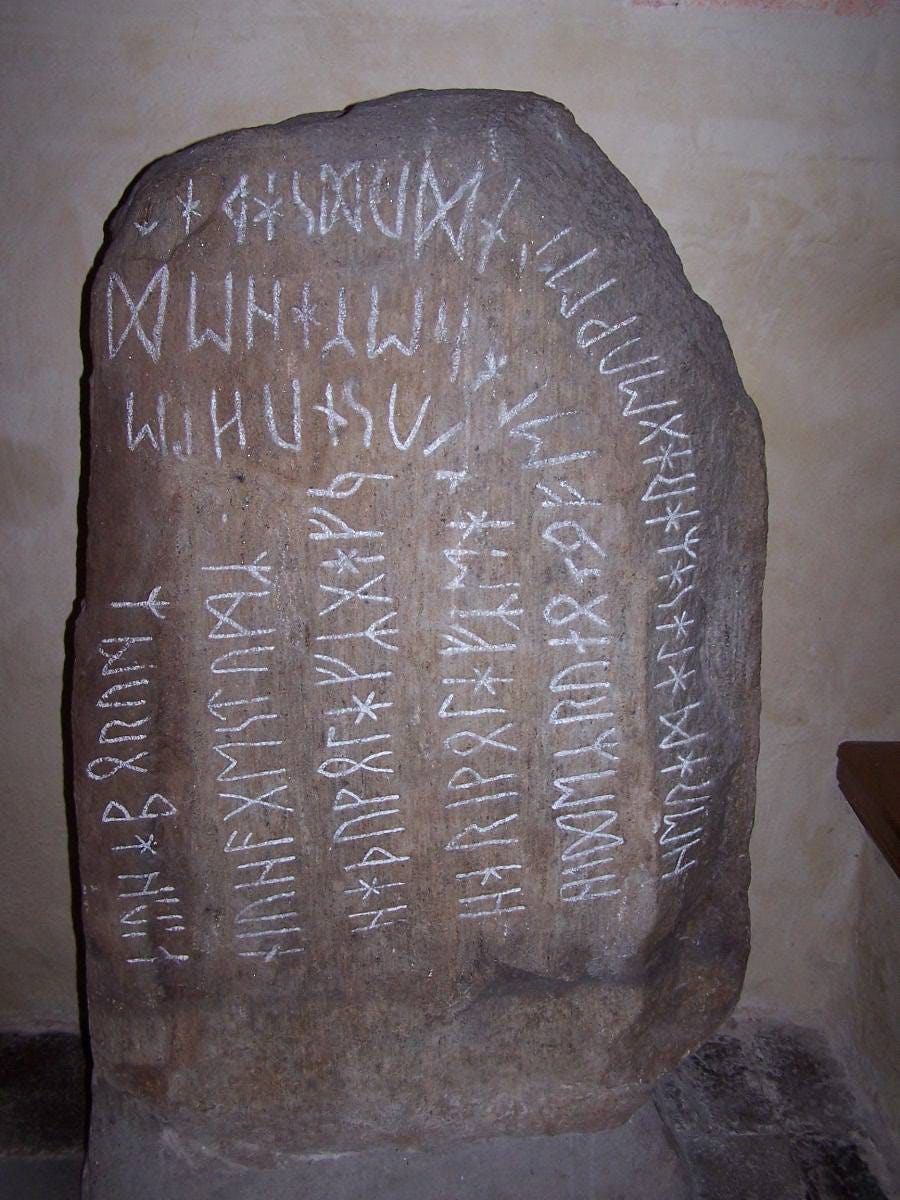
A similar point can be raised with regard to the four types of prayer in Christianity: Adoration, Contrition, Thanksgiving and Supplication—the last of which applies to what Odin speaks to in stanza 147 of Hávamál. Prayers of Supplication are prayers in which we ask to be supplied with the things for which we desire, and all the same in the Christian tradition, only ever invoking Christ for Prayers of Supplication is considered misguided and improper. He is not a ‘wish-granter,’ just as Odin warned his subjects in Hávamál.
In any case, on religiously significant days, not only were animals sacrificed in abundance by historic Pagans, but horses in particular were offered. It cannot be overemphasized just how sacred this venerable act of horse sacrifice was considered by generations of our Pagan ancestors. The mystical act of horse sacrifice rests at the very foundation of all European Pagan religions.

Horse sacrifice was so ubiquitous among the Pagan faiths that we likewise find it mentioned as particularly sacred, unique among other forms of sacrifice, in the pages of the Rig Veda, the oldest of the four Vedas and a text directly descended from the very same Proto-Indo-European religion that gave birth to all of the subsequent Pagan denominations in Europe. Horse sacrifices persisted among the Baltic Pagans as late as the 14th Century, and the horses they would purchase for this sacred rite they often bought from their Christian neighbors.
To place this into perspective, the Rig Veda was likely composed orally between 1500-1200BC. In other words, approximately 2,400+ years of tradition connect the horse sacrifices offered by those who composed the Rig Veda and the horse sacrifices offered by the European Pagans at the time of Christianization (1000AD). And this does not even account for the amount of time this rite was practiced prior to the composition of the Rig Veda.
The reason as to why neo-pagans have abandoned these most sacred rites of Pagan religion, unlike their Hindu cousins in the East, is by no means difficult to understand. The concept of routinely slaughtering a variety of animals in cult worship not only runs up against a litany of legal issues in various Western countries, but is most certainly liable to get its practitioners on their local news channel, potentially persecuted in their careers, or otherwise persecuted by their neighbors and peers, to say nothing of the financial expense.
But inevitably, this raises yet another question: since when has inconvenience prevented a person from practicing the sacred rites of their Faith?
There has been no shortage of persecution against Catholics over the past 2,000 years, but never has this prevented its adherents from holding hidden Liturgies and receiving the Blessed Sacrament in secret—even, and often, under penalty of death. And when death came, they sooner embraced it than forsook their creed. In a similar way, when the practice of horse sacrifice became banned in Iceland, the Pagans insisted that, if they abide by the new laws, that they still retain the legal right, at the very least, to consume horse flesh—which still remains legal to this very day in the country.
It is by no means inconceivable to imagine what a deeply convicted religious man would do in a circumstance in which the most sacred rites of his faith were illegal in his country. From legal campaigns, to the creation of 501(c)(3) non-profit organizations, to the fundraising necessary to uphold his sacred rites—it remains a prominent question when taking into consideration the neo-pagans we are analyzing.

In 1580, a Catholic Priest by the name of Edmund Campion offered hidden Liturgies and gave sermons to the English people, who at this time were being overwhelmed by protestant heresies. On July 14th, 1581, Campion was arrested by a protestant spy named George Eliot and taken to London. There, Campion was tortured on the ‘rack,’ a device in which a person is stretched by their ankles and wrists using a ratchet mechanism, often to the point of fracturing bones, in attempts to turn him protestant. He was offered wealth, honors and the title of Archbishop of Canterbury—all of which he declined. He was eventually hung, drawn and quartered on December 1st, 1581.
Before his execution, Edmund Campion exclaimed the following:
“In condemning us, you condemn all your own ancestors, all our ancient Bishops and Kings, all that was once the Glory of England—the Island of Saints, and the most devoted child of the See of Peter.”
— St. Edmund Campion to his jurors, November 20th, 1581.
St. Edmund Campion is today recognized as a Saint, and prayers to him seeking his intercession are often invoked with regard to Catholicism in England and literary publication.
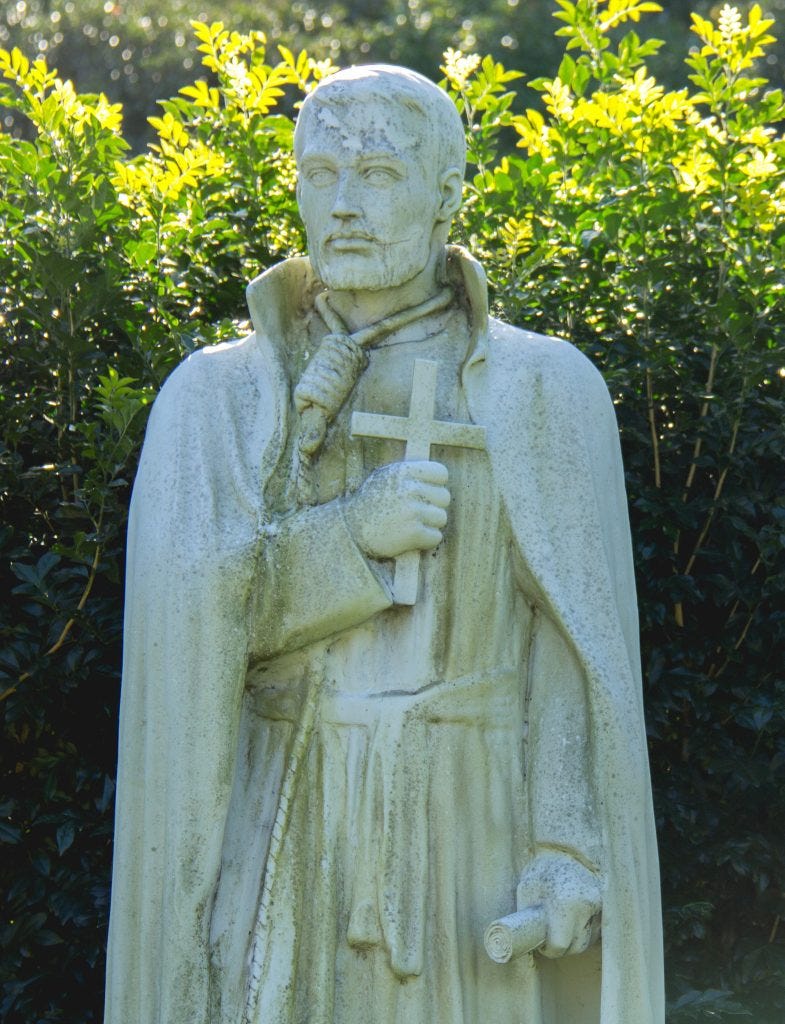
Art & Culture
The explosion in popularity we have witnessed surrounding European Paganism over the past decades can be attributable in no small part to the proliferation of wildly successful media products, ranging from videogames such as The Elder Scrolls V: Skyrim and God of War (2018), to television shows and films such as History Channel’s Vikings and Robert Eggers’ The Northman, to neo-folk bands such as Einar Selvik’s Wardruna and the band Heilung.
Let me say first and foremost that I enjoy a great many of these artistic renditions as anyone might, and I find them entertaining, (I consider Kristian ‘Varg’ Vikernes to be an excellent metal musician and an icon of Norwegian black metal,) but when such things become inextricably admixed with religion, it suddenly bears criticizing the exorbitant amount of falsehoods and fictionalizations that are interwoven within all of these modern projects—most especially those that are often erroneously considered to be faithful reconstructions of the historic Pagan past, such as the music of Heilung.
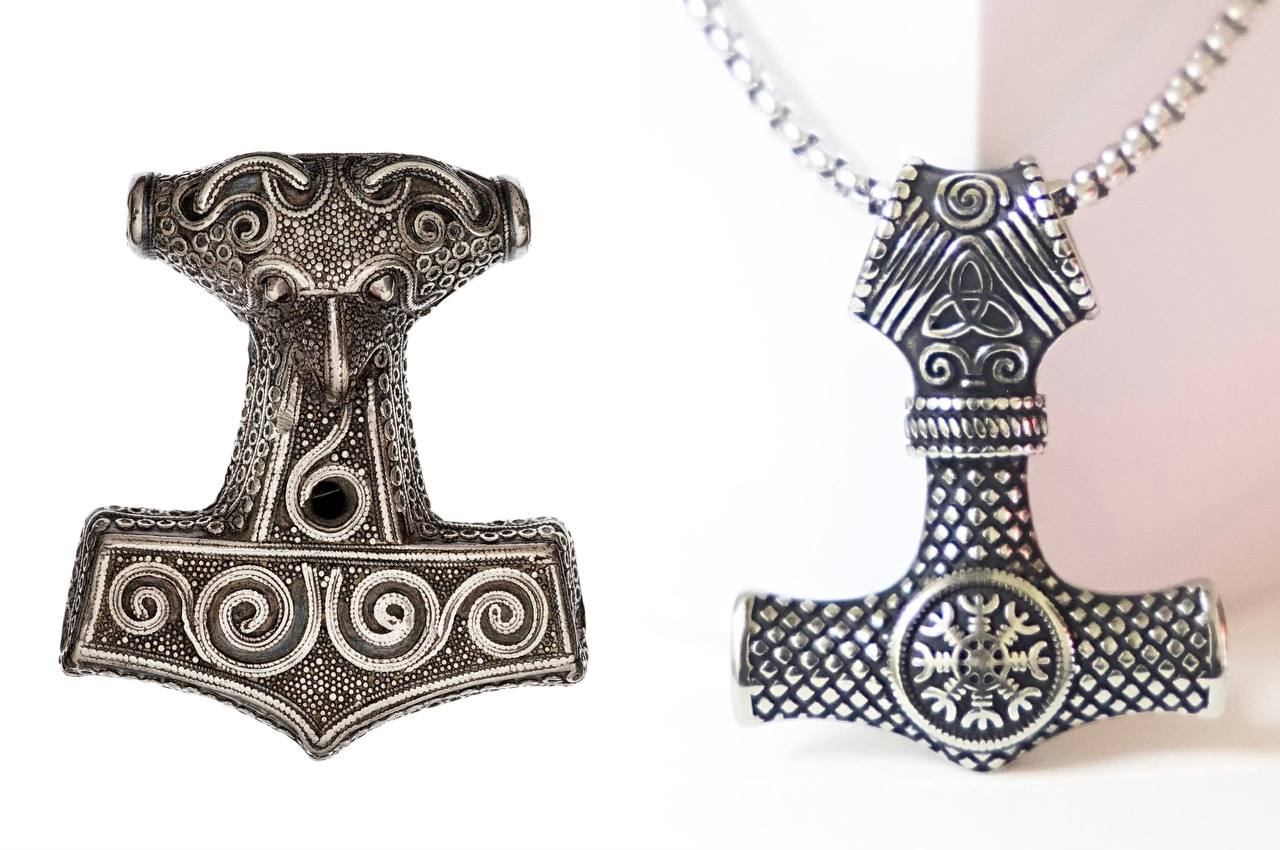
Let us recall the painting mentioned at the beginning of this article, ‘Thor's Fight with the Giants’ by Mårten Eskil Winge, where the features of Thor are altered in order to appeal to the tastes of Mårten’s Classical audience in the late 19th Century. We can observe a similar phenomena from when Norse Vikings were depicted in early films and plays wearing ‘horned helmets’ in order to give them a more frightening, demonic appearance.
We are no less susceptible to such alterations of history in the 21st Century. In the imagination of the modern mind, the Germanic Pagan of Europe was a shadowy, brooding creature mumbling shamanistic curses beneath bated breath as he rushed headlong through insidiously dark forests, various horns and bones clattering along his nude figure. But this should be considered as no more authentic than Mårten’s Romanesque Thor.
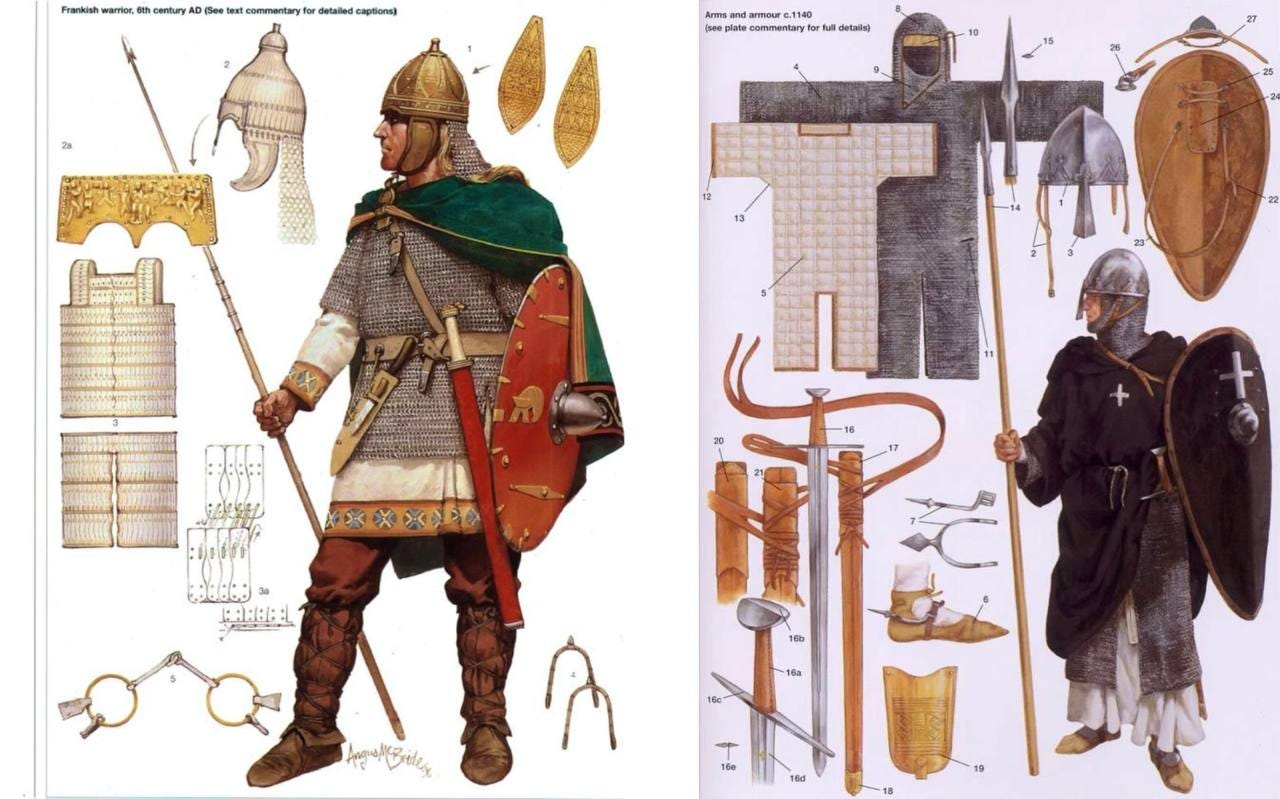
The motivation behind depicting our Pagan ancestors in these wild, uncivilized ways is to grant implication to the modern Western audience, a primarily agnostic audience, the historical existence of a long-lost ‘wild spirit,’ once liberated, (let us recall liberty being one of the foremost Enlightenment ideals,) but now crushed beneath the tyrannical boot of the all-erasing Christian Church a thousand years ago, which had tamed the Pagans of Europe, extensively polished them, and impressively spat them out in the subsequent century as the noble, graceful Knights and Princesses of Medieval Europe.
In reality, the nobility and grace of the European people has been here from the very beginning, and it should be considered nothing short of an insult to claim otherwise. The clothing, diets, music, dance, tools, virtues, vices and day-to-day lifestyles of historic Pagans and subsequent Medieval Catholics were far more alike than our modern media leads us to believe—for the Christianization of Europe was not so mighty a force that it entirely erased, and somehow replaced, the most fundamentally basic aspects of daily life.
To offer you a direct example, the music most associated with historic Paganism today is likewise that of growling, howling and throat singing—all features belonging to the music of non-European cultures, such as the Mongols and Native Americans, but utilized as a means of deliberately separating the neo-pagan movement from Christianity.
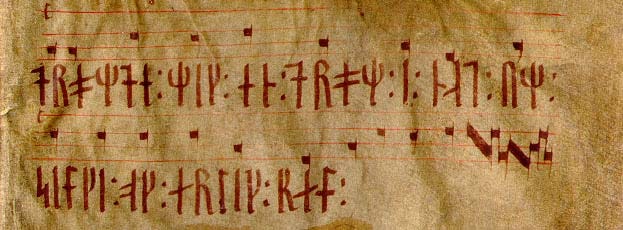
Songs and poems from ancient history are often better preserved than prose due to their intrinsic nature relying on fine details such as rhythm, rhyme and tonality. In the parchment pictured above, taken from a Danish lawbook written in 1300AD, we find a single fragment of a secular tune written in Runes. The lyrics within the parchment read: “I dreamt a dream last night of silk and fine fur.”
Unlike what is commonly believed, Christian religious music, such as Gregorian chant, was not imported into Europe as such, but rather developed out of the preexisting musical theory of Europe. Although it is true to say that the lyrical content of Europe’s music would have become Christianized, the form in which it was delivered would have remained largely unaltered. Having listened to ‘Drømde Mik en Drøm i Nat,’ let us now listen to a rendition of the ancient Christian ‘Kyrie’ chant.
To further illustrate the point that we are drawing, we might also take into consideration the reconstructed music performed by the ensemble ‘Synaulia,’ a team of musicians, archaeologists and paleontologists dedicated to applying their historical research towards reconstructing Roman and Etruscan music, that we might likewise have a glimpse of the music enjoyed by the Pagan Romans.
Now, let us compare these three melodies with audio taken of Viking reenactors singing outside of The Gotland Museum in Visby, Sweden, captured by the ethnomusicologist Farya Faraji.
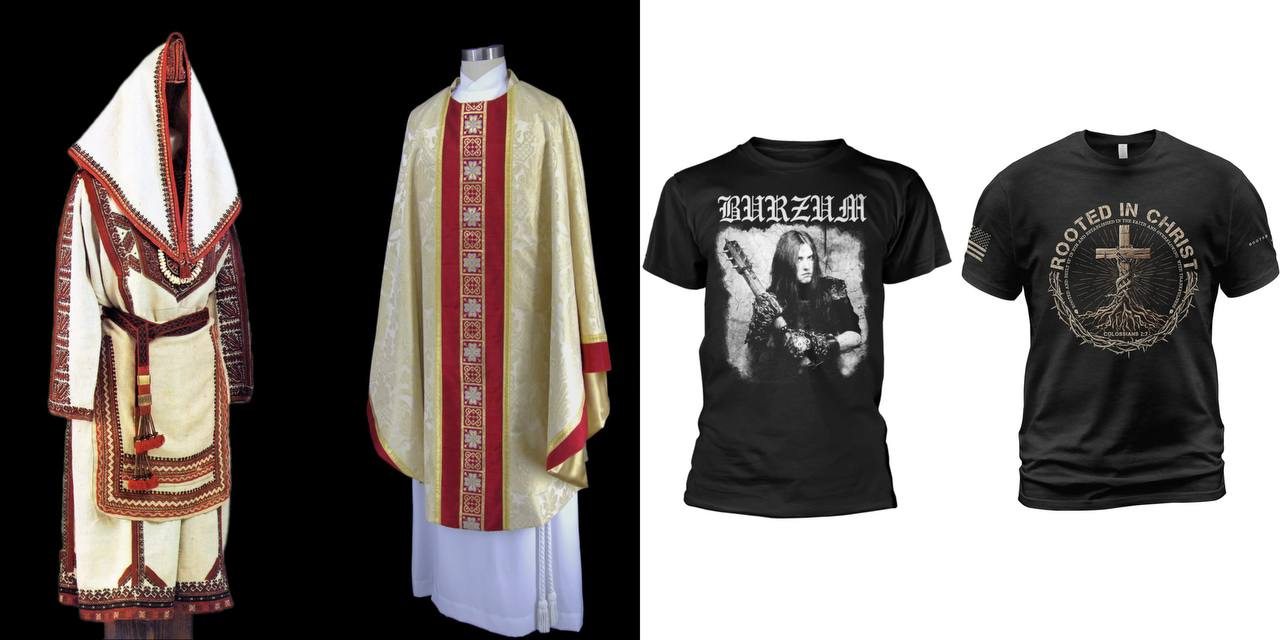
When we take into consideration all that we have outlined thus far, we can begin to formulate a far more nuanced understanding of the differences between Paganism and neo-paganism, far beyond a mere difference in time. Given what we have explored thus far in this article, I feel it would be incomplete without an honorable mention of the Catholic author and Professor of Philology J.R.R. Tolkien, as well as his literary works.
On the 7th of December, 1946, Tolkien drafted a letter to Sir Stanley Unwin in response to a German fan of The Hobbit by the name of Horus Engels, who had mailed Tolkien several illustrations he had imagined of characters depicted within The Hobbit, including Gandalf. The most kind, but nevertheless erudite Tolkien, was not particularly fond of these illustrations. He wrote to Unwin:
“I continue to receive letters from poor Horus Engels about a German translation. He does not seem necessarily to propose himself as a translator. He has sent me some illustrations (of the Trolls and Gollum) which despite certain merits, such as one would expect of a German, are I fear too 'Disnified' for my taste: Bilbo with a dribbling nose, and Gandalf as a figure of vulgar fun rather than the Odinic wanderer that I think of.”
— J.R.R. Tolkien in a Letter to Sir Stanley Unwin, Letter 107
Here we see that Tolkien took inspiration from Odin when crafting the appearance of his wise, heroic Gandalf—a patriarchal, loving figure and self-sacrificial guardian of the Fellowship in The Lord of The Rings—who likewise sacrificed himself and gloriously resurrected in an allegorically Christian manner. In a separate letter, dated October 25th, 1958, Tolkien responded to a fan asking him general questions about the philologist himself.
“I am a Christian (which can be deduced from my stories), and in fact a Roman Catholic. The latter 'fact' perhaps cannot be deduced; though one critic (by letter) asserted that the invocations of Elbereth, and the character of Galadriel as directly described (or through the words of Gimli and Sam) were clearly related to Catholic devotion to Mary. Another saw in waybread (lembas) = viaticum [The Eucharist—Body and Blood of Christ] and the reference to its feeding the will (vol. III, p. 213) and being more potent when fasting, a derivation from the Eucharist. (That is: far greater things may colour the mind in dealing with the lesser things of a fairy-story.)”
— J.R.R. Tolkien in a Letter to Robert Murray, Letter 156

Similarly to Professor Tolkien, it may well be worth pointing out that Snorri Sturluson himself, the compiler of the Poetic Edda among countless other Old Norse tales, was likewise a Catholic. And yet, when we examine the work of either scholar, nothing inhibited them from employing the aesthetic and literary treasures found in the ancient Pagan religions of their forebears.
On the contrary, both Catholic men seem to treat the figure of Odin with some marginal degree of respect: Snorri painstakingly compiling the teachings of Odin in his Hávamál, and Tolkien adopting Odin’s features for a heroic character in Lord of The Rings, who likewise held certain traits allegorical to Christ Himself, the God that Tolkien truly worshipped.
Reflecting upon this, both men do well to honor the memory of their Pagan kin without forsaking the principles of Faith they hold sacred—this in spite of the fact that neither men are polytheistic, as the neo-pagans so often claim themselves to be. This is so well conveyed within Tolkien’s work that, in the later film adaptations of The Lord of The Rings by Peter Jackson, its quintessentially religious themes are still conveyed on screen. With the context we now have regarding the similarity between Pagan and Christian music, let us now listen to this excerpt from the original soundtrack of The Lord of The Rings: Return of The King.
Conclusion
In witnessing how Snorri Sturluson and J.R.R. Tolkien, two monotheistic Christians, handle the figure of Odin when contemplating him, I posit the following objective question: would polytheistic Pagans in our time not do the same with regard to Christ?
In the very same way in which the protestant rebellions of the 16th Century did not posit atheism, yet created the subsequent “Enlightenment” that birthed large-scale atheism in the West, so too did the atheistic West eventually devolve into the subsequent neo-pagan movement despite not positing a return to Paganism; neo-paganism, with all of its atheistic blemishes and anti-sacrificial, pro-modernist traits—its primary focus being, like its protestant forebears, to complement the political inclinations of its adherents and wage war against the Church, the modus operandi of Europe for well-over a thousand years; neo-paganism, which posits that the only thing a person needs in order to faithfully abide by the Pagan religions of their ancestors is up to their own individual interpretation.
To put it bluntly: neo-paganism is post-protestantism that presents itself as ‘paganism.’
This criticism being aimed specifically towards those modernists who, just like the audience of the painter Mårten Eskil Winge, seek only to abandon any inconvenient tradition that may render ‘the old ways’ too annoying and uncomfortable for them to continue practicing. Modernists who celebrate things such as greed and lust, who completely abandon blood sacrifice, who disbelieve in the existence of, or the power of, prominent foreign deities, who look at millions of their ancestors who happened to worship Christ and admonish them, rather than render unto them the ancestral reverence they would have received from the ancestor-worshipping Pagans of yore.

Neo-paganism inverts Christian virtues, believing the Church to view Paganism with nothing other than disdain—whereas the Church views the Christian Faith as being the very fulfillment of the Pagan religions. But insofar as we criticize the inversion of Christian virtues, so too should we criticize the mutilation of them. Protestantism has stripped away much of the ritualistic, Sacramental, and hierarchical aspects of Christianity that kept the faithful in a posture of humility before the Divine for over a millennia. It should come as no surprise that, when the threads of Sacrament and Sacrifice alike are severed, Christianity and Paganism both unravel into something that is base, sinful, unrecognizable, and far more about personal empowerment and moral relativism.

Opposite to this stands Sacrifice. The Crux of all Religion. A religion without sacrifice is indistinguishable from a parade.
True Religion, that is to say the essence of Religiosity itself, whatever its form, is not the wearing of jewelry, or the echoing of righteous phrases, or arguments waged against disbelievers. True Religion is, and always has been, the degree to which we sacrifice ourselves to the Divine; the interplay between birth, death and Rebirth, of Heaven and Earth, of God and man.
Let it be stated plainly that it is not by mere accident that the very symbol of the Christian faith is the Cross. To which, in conclusion, I invite those true polytheist readers, to freely take up. For there is nothing within your faith that inhibits you from doing so.
( — P.S. Readers have my express endorsement to refer to protestants as neo-christian )



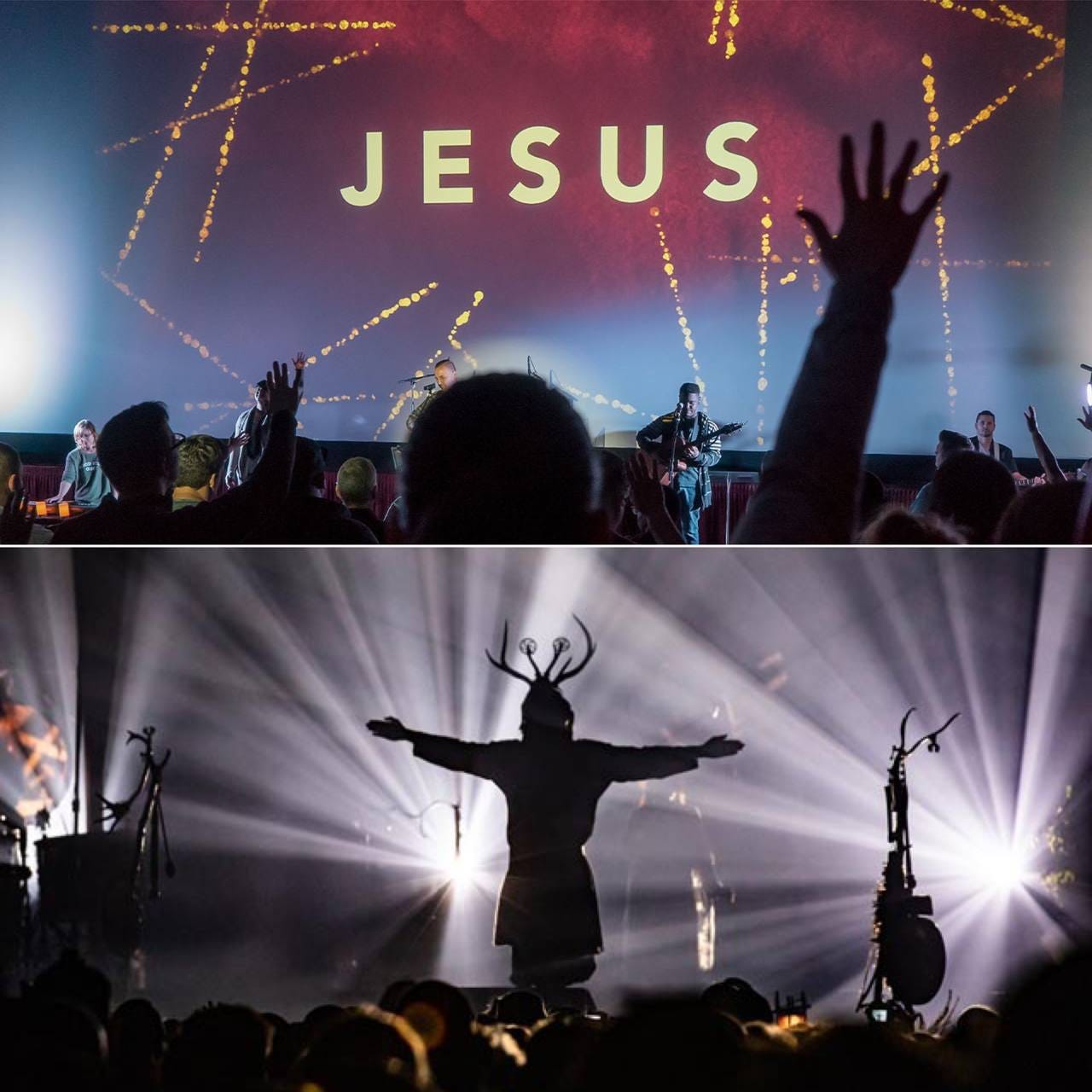

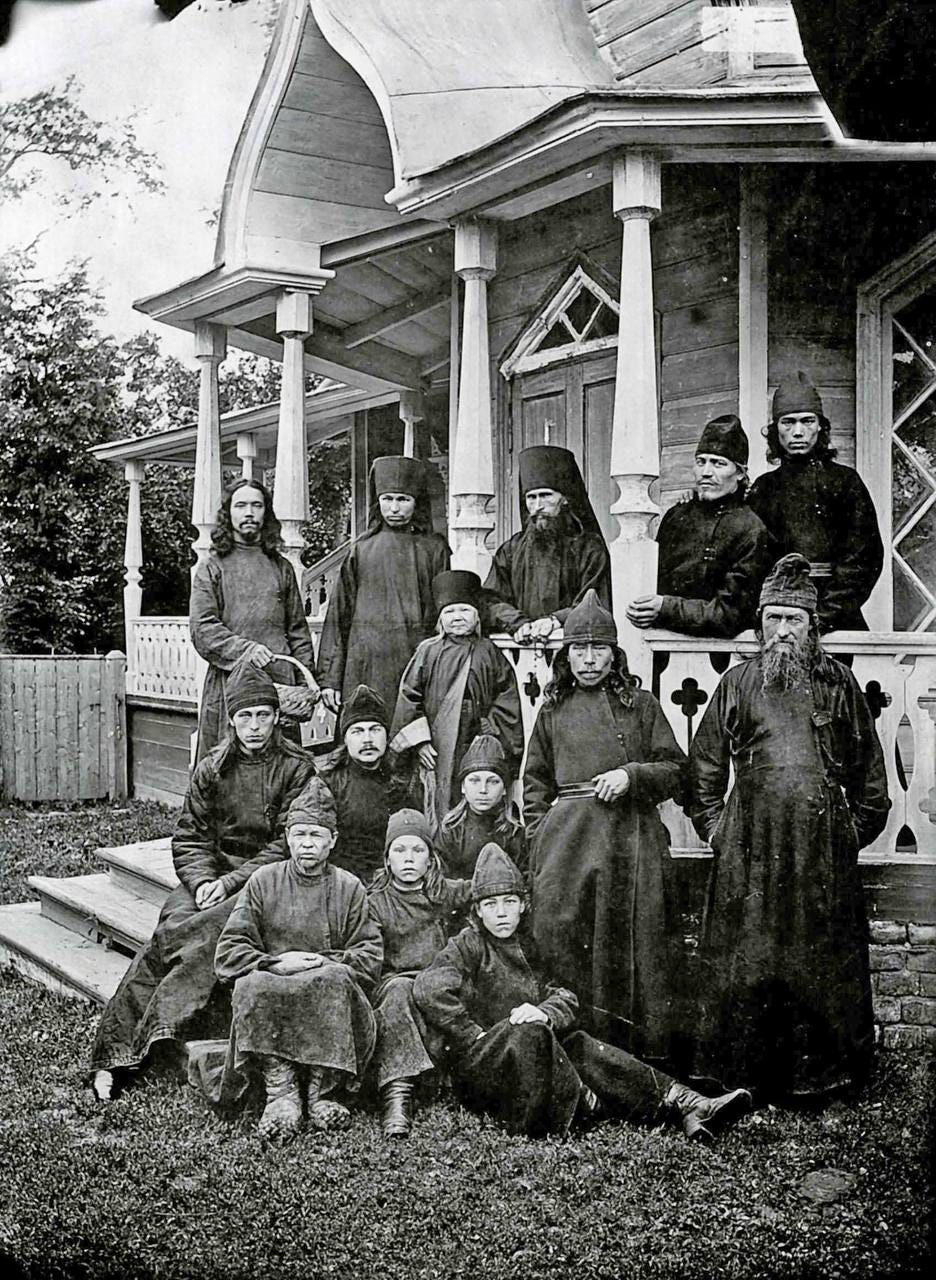

Chesterton says something about paganism being the only true competitor to the church. The rest is agnosticism.
I'll admit up front I didn't read the entirety of the article, I agree with the broad thesis that modern day society is pagan in orientation. I disagree with the contention that protestantism is paganism. In Traditional Catholic theology, heresies are practical atheism. The main difference between the pagans of past (Saxons, Franks, Goths, and pagan Romans) is that the pagan barbarians worshipping God under different guises (war, night, sex, harvest, ect,ect,) were doing it out of a honest but mistaken believe. Where as today's heretics are willfully and stubbornly denying Catholism out of pride and willfulness. They are worshipping THEMSELVES, whether they know it or not. When you deny God's Truth out of selfish motivations this makes you a practical atheist. Fortunately, the self proclaimed pagans, protestant, and false catholics, their commitment and knowledge is a inch deep and a mile wide. The founding members of our government (Franklin, Jefferson, Washington, and others) were freemasons who worked with the freemasonic revolutionaries in France to overthrow King Louis XVI. They also imported the pagan flavor of the French revolution. Freemasonry in orientation is the overthrow of Catholism and the Catholic Church and a return to paganism. Which explains the hostility of the American government towards the Catholic Church PRIOR to the Vatican II Council. I would suggest if he wants to understand the the neo pagan orientation of present day culture and society to study freemasonry.